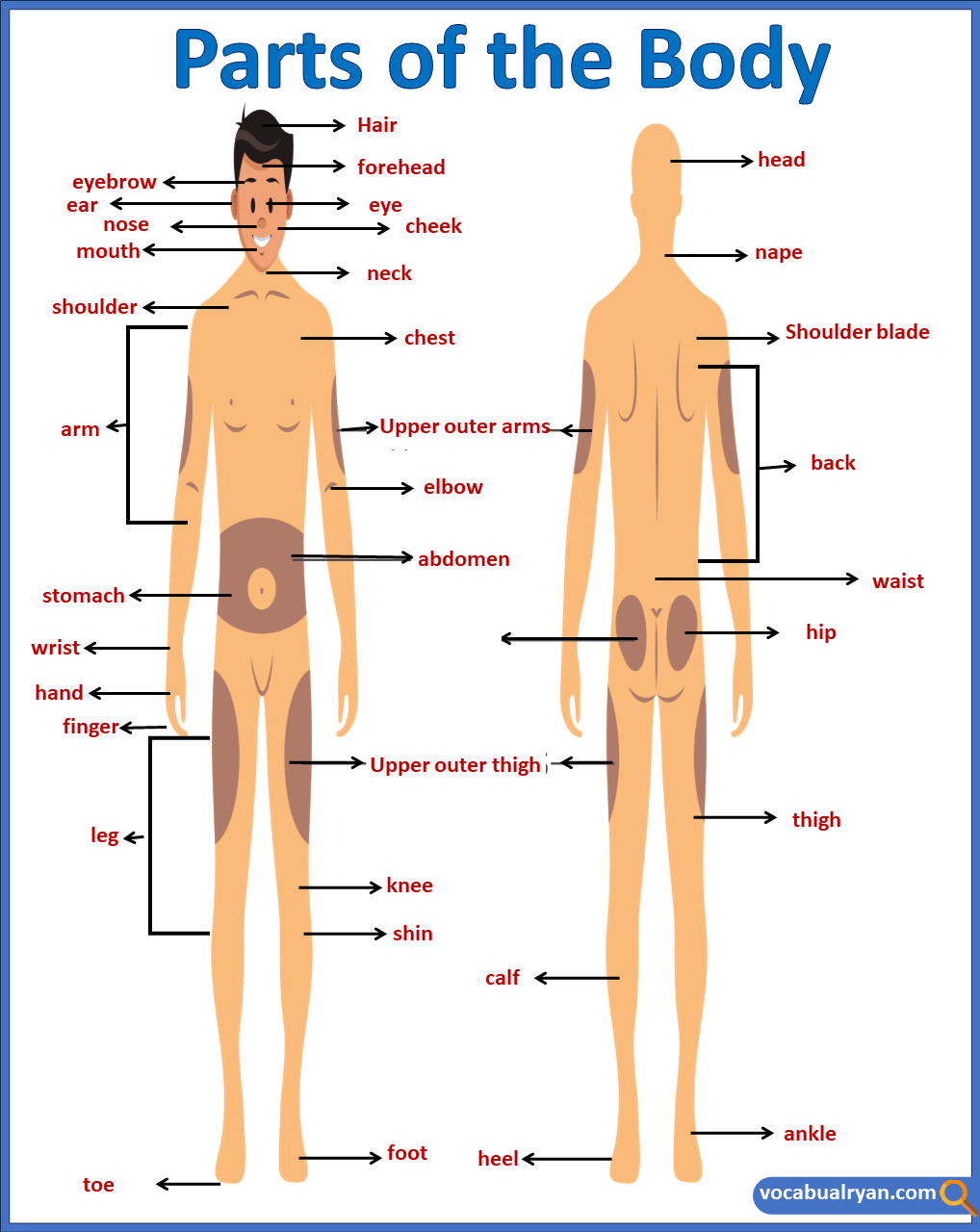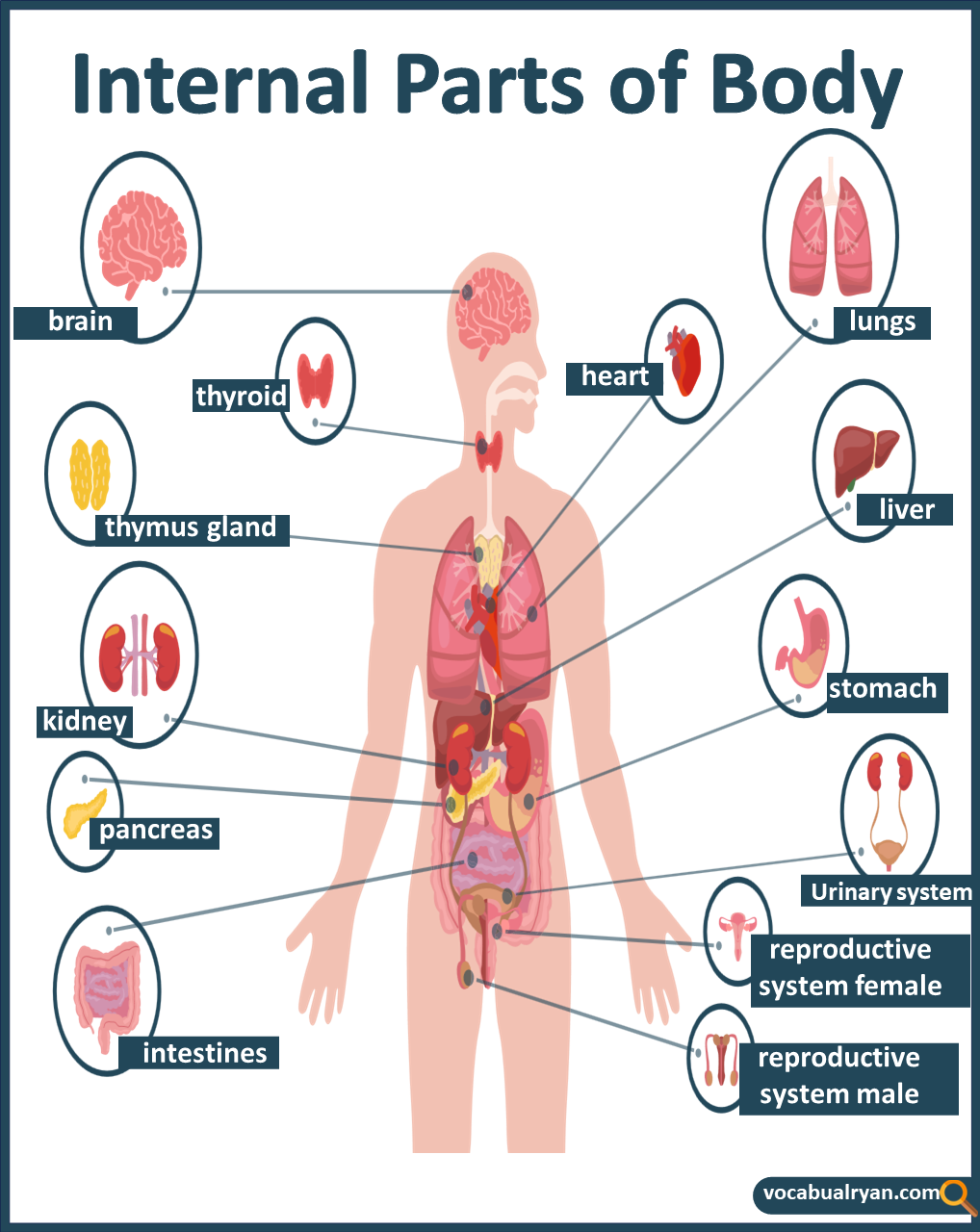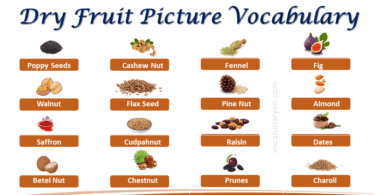Learning body parts name with pictures helps students and beginners identify, remember, and talk about the human body confidently. These names are often used in schools, health checkups, and daily conversations. By learning them with images, it becomes easier to connect words with real meanings. This post includes all important internal, external, male, and female body parts. It’s designed for vocabulary building using a picture-based method that supports accurate learning.
List of All Human Body Parts with Images
This part covers common human body parts that we see and use daily. These are useful for health, school, or basic English skills.
- Head
- Hair
- Forehead
- Eyebrow
- Eye
- Eyelid
- Eyelash
- Nose
- Nostril
- Cheek
- Ear
- Lips
- Teeth
- Tongue
- Chin
- Neck
- Shoulder
- Arm
- Elbow
- Forearm
- Wrist
- Hand
- Palm
- Fingers
- Thumb
- Chest
- Waist
- Back
- Stomach
- Hip
- Leg
- Thigh
- Knee
- Calf
- Ankle
- Foot
- Heel
- Toe
- Spine
- Groin
- Collarbone
- Jawline
- Navel

Head Parts Name in English with Pictures
These body parts are located on the head. They are useful in speaking, looking, and understanding emotions.
- Hair: Grows on top and is styled or cut as needed
- Scalp: Skin covering the skull, holds the hair roots
- Forehead: Flat area often used to check for fever
- Crown: Top part of the head where hair swirls
- Eyebrow: Hairy line that gives shape to the eye area
- Eye: Main organ for vision and blinking
- Eyelid: Thin skin that closes over the eye for rest
- Eyelash: Short curved hairs that protect the eye
- Nose: Smells scents and takes in fresh air
- Nostril: Small holes that let air in and out of the nose
- Ear: Helps you hear and locate sounds
- Cheek: Area that turns red when smiling or shy
- Temple: Soft part at the side of the forehead
- Jaw: Lower part of the head that moves while chewing
- Chin: Helps shape the face and supports lower jaw
Face Parts Name with Pictures for Kids and ESL
This section covers body parts found on the face. These are important for eating, talking, and showing feelings.
- Lips: Move during speaking and form mouth expressions
- Teeth: Chew food and help shape the mouth
- Tongue: Tastes food and helps form sounds
- Eyes: Let you see everything around you
- Ears: Catch sounds from near and far
- Eyebrows: Help show feelings like anger or surprise
- Eyelashes: Stop dirt from entering your eyes
- Jawline: Curved edge that shapes the lower face
- Cheekbone: Raised area just below the eyes
- Dimple: Small skin fold that appears when smiling
Upper Body Parts Names in English
Upper body parts help us lift, write, carry, and do many daily actions.
- Neck: Holds up the head and moves side to side
- Shoulder: Lets arms move in wide directions
- Collarbone: Bone between neck and shoulder
- Arm: Whole limb used for lifting and holding
- Elbow: Bends the arm to bring things close
- Forearm: Helps move the wrist and lower arm
- Wrist: Bends and turns the hand smoothly
- Hand: Used to wave, write, and pick things
- Palm: Inner part used to hold and feel objects
- Fingers: Help with tasks like typing and eating
- Thumb: Makes grabbing and pinching easier
- Chest: Area where you breathe deeply
- Waist: Helps the body twist and turn around
Lower Body Parts Name with Picture and Label
These parts allow standing, sitting, walking, and moving from place to place.
- Back: Supports your posture and body weight
- Spine: Runs down the back and supports movement
- Stomach: Helps in food digestion and body balance
- Navel: Small round spot in the middle of the belly
- Hip: Supports movement between upper body and legs
- Groin: Soft area between thigh and stomach
- Leg: Used for walking, kicking, and jumping
- Thigh: Has strong muscles for motion
- Hamstring: Back part of the upper leg
- Knee: Lets the leg bend while sitting or climbing
- Shin: Front part of the lower leg
- Calf: Tightens when walking or running
- Ankle: Helps the foot turn and move
- Foot: Balances the body and touches the ground
- Heel: Back lower part that strikes the floor first
- Sole: Bottom of the foot that touches the ground
- Toe: Helps with walking and balance
- Instep: Raised part on the top of the foot
- Toenails: Hard covers on each toe
Outer Body Parts Used in Daily Life
These parts help in wearing clothes, cleaning, and expressing actions.
- Skin: Covers and protects everything inside the body
- Fingernails: Hard layer on fingers, trimmed regularly
- Toenails: Hard layer on toes, also trimmed often
- Cuticles: Small skin near the nail base
- Elbow Skin: Bends with the elbow and feels rough
- Hairline: Edge where forehead meets hair
- Jawline: Curves along the side of the lower face
- Armpit: Underarm area that sweats during heat
- Buttocks: Used for sitting and keeping balance
- Neckline: Edge around the top of a shirt
Internal Body Parts Names with Pictures
Internal body parts are hidden inside and do jobs like breathing, thinking, or digesting.
- Brain
- Heart
- Lungs
- Liver
- Kidneys
- Stomach
- Intestines
- Bladder
- Pancreas
- Esophagus
- Gallbladder
- Spleen
- Diaphragm

Important Organs in the Human Body
These key organs keep the body healthy and active.
- Brain
- Heart
- Lungs
- Liver
- Stomach
- Intestines
- Kidneys
- Pancreas
- Bladder
Body Systems and Their Parts with English Names
Each system is a group of body parts working together.
- Nervous System: Brain and nerves control actions and reflexes
- Respiratory System: Nose and lungs help you breathe
- Circulatory System: Heart and vessels move blood
- Digestive System: Mouth and stomach digest food
- Skeletal System: Bones give shape and support
- Muscular System: Muscles help you move and lift
- Immune System: Fights illness with white blood cells
- Reproductive System: Male and female parts that help in reproduction
- Urinary System: Kidneys and bladder remove waste
Male and Female Body Parts Names with Pictures
Male and female bodies have some different parts used in growth and health.
Female Body Parts in English with Image and Use
These body parts are important in birth and monthly changes.
- Breasts
- Areola
- Ovaries
- Uterus
- Cervix
- Vagina
- Clitoris
- Fallopian Tubes
- Urethra
Male Body Parts List with Functions
These parts are for growth, reproduction, and male features.
- Penis
- Testicles
- Scrotum
- Prostate Gland
- Epididymis
- Vas Deferens
- Urethra
Full Body Parts Chart for Learning Vocabulary
This chart sums up all parts learners must know. It’s good for classroom review and picture-based learning.
- Head
- Face
- Neck
- Arm
- Hand
- Chest
- Waist
- Leg
- Foot
- Internal Organs
- Male and Female Parts
You May Also Like




Leave a Comment